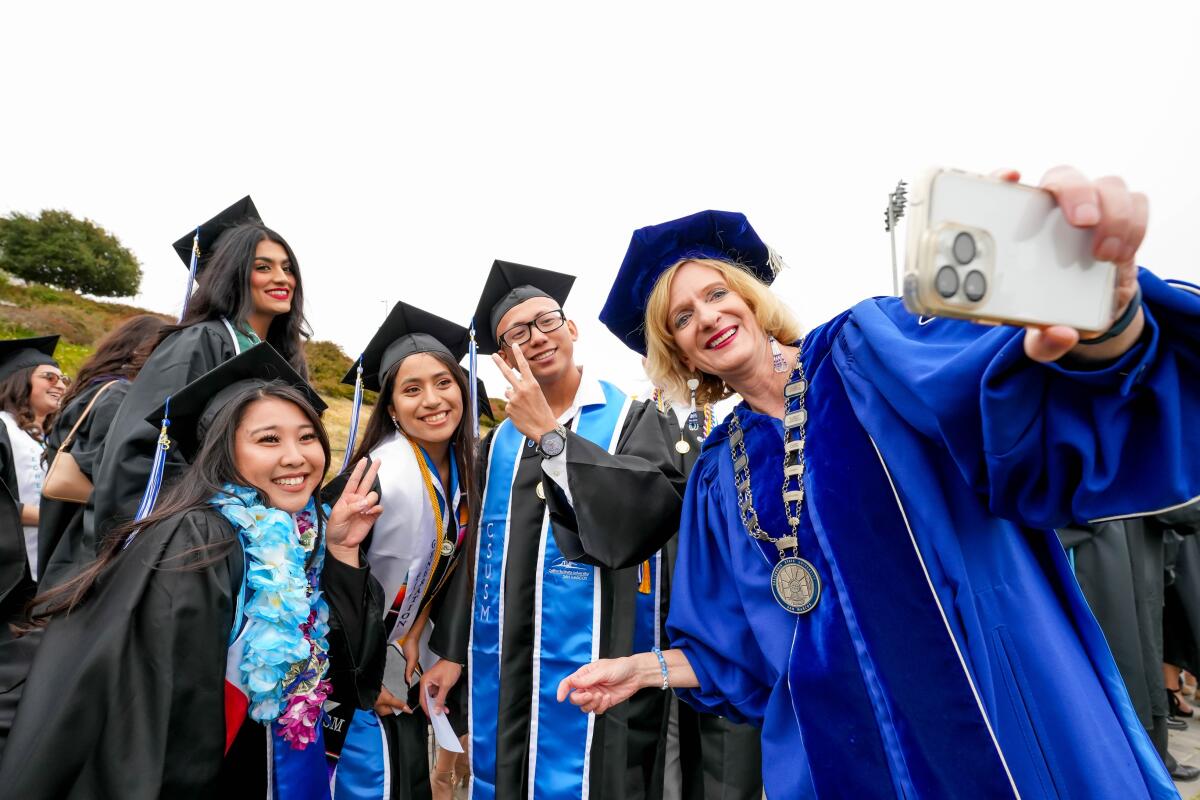Opinion: At CSU San Marcos, ‘non-traditional’ students are the new normal. Here’s what that means.

Cal State San Marcos recognizes that education is a tool that helps students overcome barriers and unlock their potential.
Neufeldt, Ed.D., has served as president of Cal State San Marcos since 2019 and lives in Escondido.
During May and June, young adults are graduating high school and preparing for the next chapter in their lives. For some, the options may be plentiful and their futures undeniably bright; for others, the road ahead might not be so clear. If they haven’t already done so, parents are sitting down with their high school graduates and running the numbers on the affordability of college, with some wondering if it’s worth the investment. Studies say yes: College is worth the investment both personally and financially.
A March report from the Public Policy Institute of California shows that today’s labor market increasingly rewards highly educated workers. In 1990, a worker with a bachelor’s degree earned 39 percent more than one whose highest level of education was a high school diploma. By 2021, the difference had grown to 62 percent (and closer to 90 percent for workers with graduate degrees).
In recent weeks, on campuses around the region and the nation, students have begun to celebrate a remarkable achievement and a pivotal moment in any life journey: graduation. This week, a diverse group of graduates will share essays about their successes and challenges. Congratulations!
Cal State San Marcos recognizes that education is a tool that helps students overcome barriers and unlock their potential for lifelong success. This is not only beneficial for individuals and families, but for organizations, industries and society. It leads to a broader talent pipeline, innovation, social equity and economic mobility.
However, higher education in the United States has historically contributed to the socioeconomic divide instead of closing it. This has been exacerbated by national college rankings that have prioritized exclusivity in admissions rather than broad access. Fortunately, organizations like CollegeNet have published a Social Mobility Index to measure the movement of individuals from one socioeconomic status to another. In 2022, Cal State San Marcos ranked first among more than 1,400 colleges and universities, indicating that we excel at giving students the opportunities to succeed in the modern workforce while having the means and social awareness to give back and empower others to follow in their footsteps.
On May 20, 4,236 students graduated as part of the CSUSM class of 2023; 57 percent of the graduates are the first in their families to earn a bachelor’s degree and 32 percent are the first to attend college. More than 45 percent come from traditionally underrepresented backgrounds. The ages of the graduates range from 19 to 75.
These factors make the majority of our students “nontraditional,” although I would argue that nontraditional is the new tradition. We believe it’s essential to provide access to higher education in an affordable way, broaden the educational pipeline, commit to student success and graduate students into high-quality jobs.
Connected to our mission of student success and social mobility, CSU San Marcos works to intentionally connect our work on campus with the local community. This connection helps students integrate their learning and prepares them to become future leaders who can tackle complex challenges.
Examples of our innovative partnerships include our Alliance program, founded in 2013, which now has agreements with over a dozen K-12 school districts to offer guaranteed admission to qualifying students, expanding access to higher education for those who may not otherwise consider it an option. And last year, we partnered with the Coalition of Black and African American Education, an outcome of our Black Student Success initiative. This partnership strengthens our efforts to support students of all backgrounds in enrollment, retention and campus climate.
In San Diego County, 100 percent of job growth in the past five years was in careers that required a degree or higher education credential. It’s why it’s crucial to produce graduates who can meet the current and future needs of regional economies.
And the advantages of obtaining a higher education are enormous. The study I referenced earlier also found that workers in the Golden State with a bachelor’s degree earn a median annual wage of $81,000 and only 12 percent of workers with no more than a high school diploma earn that much. A college education benefits our students, our economy and the future of our region.
I am proud that 8 in 10 CSU San Marcos graduates remain in Southern California, contributing to our local economy and assuming high-demand positions in fields such as health care, social work, engineering, logistics, cybersecurity and education; these industries are thirsty for a new crop of bright minds to fill these roles. Highlighting the positive return of investment of a college education for this year’s high school grads, especially the new “tradition” of students and their families, is critical to unlocking their potential for lifelong success.
Get Weekend Opinion on Sundays and Reader Opinion on Mondays
Editorials, commentary and more delivered Sunday morning, and Reader Reaction on Mondays.
You may occasionally receive promotional content from the San Diego Union-Tribune.






